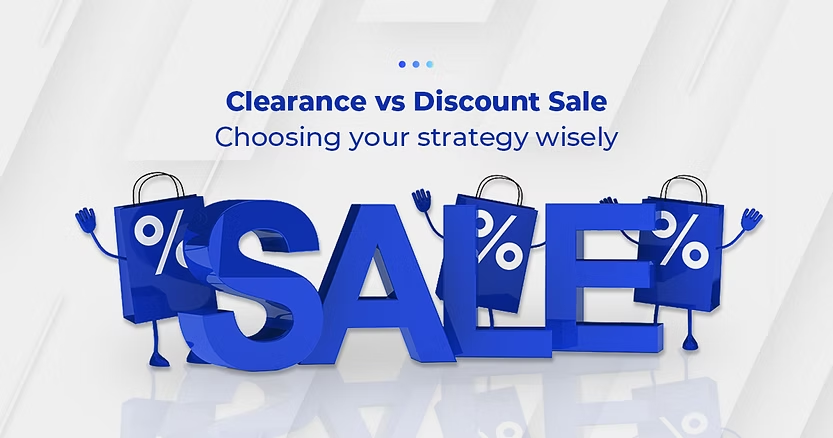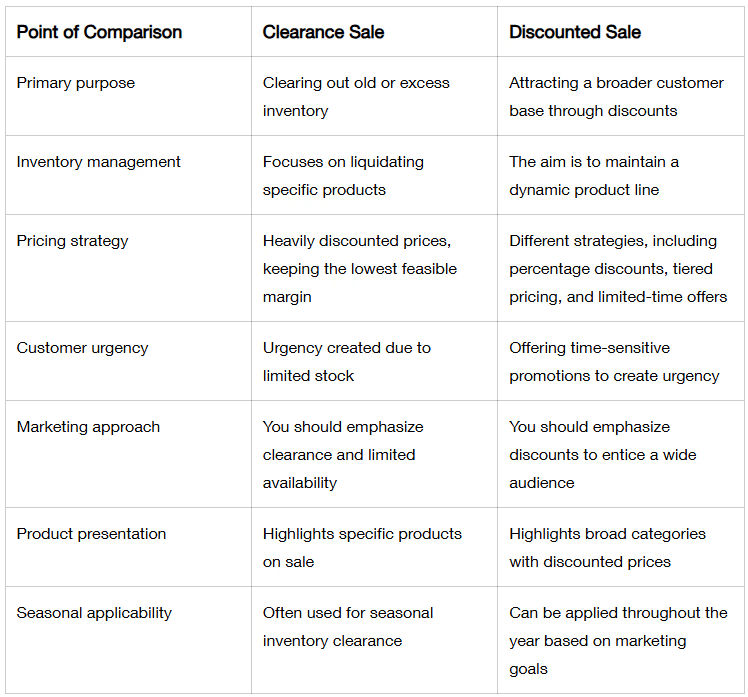
In eCommerce, where trends shift as quickly as a cursor clicking through webpages, it’s essential to master your sales strategy. Businesses struggle with the challenge of offering new products while ensuring these products reach the hands of eager consumers.
This quest has given rise to various sales strategies, each with its unique pull and effectiveness. Among these, we’ll be talking about the two that customers love the most—clearance sales and discounted sales.
In this post, we will look at the nuances of these strategies, understand what they are, their differences, and some tips to maximize their potential.
Clearance sales have a different goal compared to other strategies that businesses use to drive sales: to clear out old or excess stock and pave the way for new products. This is a crucial strategy for effective inventory management.
This sales strategy is accompanied by significant price reductions, which creates a sense of urgency among customers to capitalize on the unmatched cost savings. It's important to note that because the primary objective of clearance sales is inventory clearance, the items featured might not align with the current market trends.
Since the primary focus is on making room for new inventory, you may choose to offer these items at heavily discounted prices. Consequently, customers exploring clearance sales will focus on the appeal of substantial discounts rather than the latest or highest-quality products.
So, if you’re transparent with your customers that the sale is a clearance sale, you can align customer expectations and rest assured that they won’t be surprised if it doesn’t feature a product they love.
Discounted sales, on the other hand, are more focused on attracting a broader customer base through price reductions. Unlike clearance sales, the purpose here is not solely to clear out old inventory but to entice customers with appealing discounts, which helps build loyalty and encourages repeat business.
Discounted sales can take various forms, including percentage-based discounts, tiered pricing, or limited-time offers. It’s the versatility of this strategy that allows businesses to create their approach based on specific goals, target audiences, and market conditions.
Now that we know what clearance sales and discounted sales are, let’s look at the differences between them to help you understand which strategy you should opt for, keeping your goals in mind.

Let’s say, you want to bring in a new product line but are not able to because a lot of your old products are still in stock but low in demand. In that case, running a clearance sale is the best option for you because it’s better to bring in new products that bring sales than holding on to the ones that are not in demand.
On the other hand, if acquiring new customers is your goal, run discounted sales on products that are in trend. It’ll attract a broader customer base, ensuring that more people notice your brand.
Timing is crucial when it comes to clearance sales. To maximize impact, consider launching these sales events at the end of a season or when new inventory is set to arrive. This ensures that customers perceive genuine value and urgency in purchasing discounted items.
Make your clearance sales more attractive by offering bundle deals. Bundle complementary products together, encouraging customers to buy more items, so even if you’re not making any profit on the product to be cleared, you’ll make some on the complimentary product.
Build customer loyalty by extending exclusive offers to loyal customers during clearance sales, like giving them early access. This acknowledges their support and incentivizes repeat business.
Use social media to create anticipation for clearance sales. Create engaging teasers, sneak peeks, and countdowns to generate excitement and attract a larger audience.
Encourage customers to become ambassadors for your brand by creating user-generated content during clearance sales. Offer an extra discount or exclusive deal in exchange for social media posts or Google reviews. This builds brand awareness and allows you to use the influence of satisfied customers to attract new ones.
Use the spotlight on clearance items to strategically feature your new collections or products. Ensure that customers exploring clearance sales also take notice of your latest offerings, expanding their shopping experience and potentially increasing sales across different product lines.
Run clearance sales to clear out products that are available in only one size or broken sizes that may not fit traditional sizing categories. Offer these items at attractive prices, attracting customers who may specifically be looking for unique or limited-size options and effectively clearing out stock that might otherwise linger.
Implement tiered discounts to entice customers to spend more. For example, offer a 10% discount on purchases over $50 and a 20% discount on purchases over $100. This strategy boosts average order value and rewards higher-spending customers.
Here’s a strategy you can use to run tiered discounts. Divide your product offerings into three different categories: Best-selling, BAU, and dead products.
Best Selling Products: These high-demand items will feature a minimum discount, ensuring that loyal customers can still enjoy savings while buying popular products.
BAU (Business As Usual) Inventory: Products in this category, representing your standard inventory, will boast more generous discounts. This encourages customers to explore beyond the tried and true, potentially discovering new favorites.
Dead Stock: Maximize the appeal of items in this category by offering the highest discounts. This helps in the clearance of older stock and also attracts bargain-hunting customers seeking exceptional deals.
By tiering discounts based on inventory categories, you can guide customer preferences, optimize stock turnover, and provide tailored savings for different segments of their product lineup.
Create a sense of urgency by incorporating limited-time offers into discounted sales. Clearly communicate that the discounts are only available for a specific period, prompting customers to make quick and impulsive purchase decisions.
Integrate discounted sales with a loyalty program to enhance customer retention. Offer additional discounts or exclusive deals to customers enrolled in the loyalty program, encouraging them to continue choosing your brand.
During discounted sales, use cross-selling and up-selling techniques to maximize revenue. Recommend complementary products or suggest upgrades, providing customers with additional value and encouraging them to explore more offerings.
Attract new customers by introducing first-time shopper discounts during sales events. Offering exclusive discounts to first-time buyers incentivizes initial purchases and lays the foundation for building customer loyalty.
When it comes to running sales on your eCommerce store, experimentation is key.
You must explore different sales strategies and closely analyze their outcomes. Tracking performance is not just advisable; it's essential to ensure precision in eCommerce.
Like a skilled archer aiming for the bullseye, if you’re armed with data and insights, you can find the golden combination that leads to your success.
With Graas, you can do product analysis to identify your best and worst-performing products, which helps you decide which type of sale you will run on them. Grass also enables you to identify cross-selling and upselling opportunities. It recommends the bundle options you can create to maximize your AOV.
Use business and marketing analytics to measure the success of your sales strategies and experimentations with Graas, and see how you can turn your data into more revenue. Sign up today!